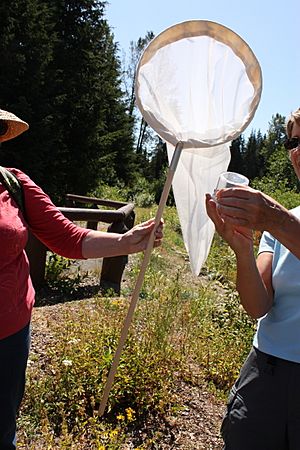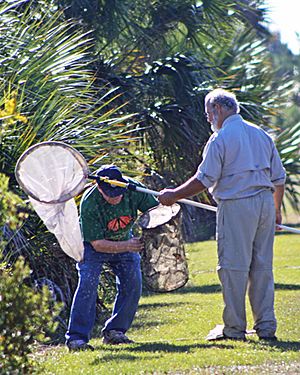Butterfly count facts for kids

Butterfly counts are a way to estimate how many butterflies live in a certain area. People often do these counts in North America and Europe.
Usually, people who love nature and want to learn more about butterflies in their local area do these counts. They are often volunteers, not professional scientists. A butterfly count usually happens at a specific time each year. Sometimes, many counts happen at the same time across a park, county, or even a whole country. The information gathered is often shared with butterfly experts and researchers. This data helps them understand if butterfly populations are growing, shrinking, or staying healthy.
Contents
Who Organizes Butterfly Counts?
Many different groups can organize butterfly counts. These include professional organizations, universities, nature clubs, schools, and nature preserves. Parks and amateur groups also help. Often, people who join the counts get training. This training helps them learn how to identify different butterfly species. For example, the North American Butterfly Association organized over 400 counts in 2014!
Different Ways to Count Butterflies
There are several ways to count butterflies. The main difference is between "restricted searches" and "open searches." Most counts aim to count all the butterflies seen in one place. The goal is to guess the total number of butterflies in a larger area by looking at a smaller part of it.
Sometimes, counts focus on just one type of butterfly. Other times, people count butterflies as they fly from one place to another. A famous example is the yearly migration of monarch butterflies in North America. Some projects tag butterflies to track their migration paths. However, these are usually migration studies, not regular butterfly counts. Butterfly counts can also happen where many butterflies gather, like a winter roost. For instance, people count western monarch butterflies when they gather in California, Mexico, and Arizona for the winter.
Restricted Searches: Transects
These are often called "Pollard Transects" or "Pollard Walks." A transect is a special way to record butterfly sightings. Ernie Pollard first described this method in 1977. In a transect, one person walks a set path at a steady speed. They do this many times during a season. They count butterflies seen within about 2.5 meters (8 feet) on either side of the path. They only count butterflies seen in front of or above them. Sometimes, a second person helps identify or photograph the butterflies. These paths should stay the same every year. It's best if they cover different types of natural areas.
Some long-running restricted searches include Art Shapiro's Butterfly Project in the U.S. (started in 1972) and the UK Butterfly Monitoring Scheme (started in 1976).
Open Searches
Open searches are also called "checklist searches." They focus on finding out which butterflies are present and how many there are in an area. These can be one-time events, like the North American Butterfly Association's counts in July. Or, they can be regular counts done by individuals or groups. Because they are less strict, they are great for many citizen science programs. Citizen science means regular people help collect scientific data.
Studies show that open searches often find more types of butterflies in an area. This is because during an open search, the person counting can look for places where butterflies usually live or gather. This is different from following a fixed path like in a transect.
Simple Butterfly Checks
To get more people involved, researchers in Austria suggested a simpler way to check butterflies. Regular people could do basic checks, while experts would do more detailed ones. They tested this by comparing data collected by students with data from professional experts. Even with some small mistakes in identifying butterflies, the students' data helped predict the general health of butterfly habitats.
Opportunistic Sightings
Opportunistic sightings are butterfly sightings that are not part of a planned count. This is when someone just happens to see a butterfly and reports it. For example, if you see a cool butterfly in your garden and tell someone about it, that's an opportunistic sighting.
Atlas Projects
Atlas projects are a special type of open search. They usually focus on a specific area, like a state or province. The goal is to find out which butterfly species are present or absent. This usually happens over several years. Each atlas program has its own rules for data. They often accept data from transects, counts, and opportunistic sightings to build a large database. The longest-running atlas program in North America is the Ontario Butterfly Atlas Online. It started collecting data in 1969.
How to Estimate Butterfly Numbers
People doing counts use different ways to estimate large groups of butterflies:
- Estimating butterflies gathered along lines, like a fence or river.
- Estimating butterflies in a uniform area, like a field.
- Estimating butterflies on certain plants.
- Estimating butterflies flying in the air.
Sometimes, the number of butterflies is estimated by the size of the area they cover. For example, the wintering monarch butterfly population in Mexico is measured in hectares (a unit of area). Butterflies can also be counted in their different life stages, like eggs, larvae (caterpillars), and instars (stages between molts).
Sometimes, butterflies are caught, tagged, and then released. If these tagged butterflies are found again in a certain area, it helps scientists figure out the population size and where the butterflies are flying.
See also




